8 Key Strategies for Successful Content Marketing in Drug Rehab Centers
More so than in other industries, drug rehab centers must focus on building a relationship with even potential leads. Whether the potential patient or family member found you through an internet search or a Facebook ad, from the minute they land on your virtual doorstep (your website), every piece of content must be tailored to address their problems.
This is why content marketing for addiction treatment centers is crucial to your healthcare marketing strategy for drug rehab centers. Your rehab content marketing communicates a message that builds relationships with potential leads. If you do a good job of that, you'll be much more likely to attract more new patients through content marketing.
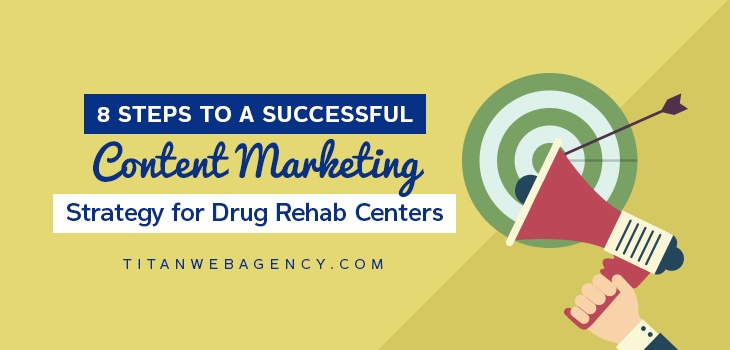
Therefore, content marketing for drug rehab facilities is one of the most important online marketing strategies you could employ! You aim to create valuable content that allows you to build relationships with potential clients based on loyalty and trust.
Many centers, however, make the mistake of not completely understanding what an effective content marketing strategy looks like. You may have spent thousands of dollars on your website and local SEO, but if you don’t have the content to back it up, you won’t see the recurring traffic you need to build trust.

Step 1: Identify Your Target Persona
Before you can create content, you need to identify your target audience or persona. This isn’t a description of any one potential patient or patient but a generalized overview of the audience you will be marketing to.
Start by giving this “persona” a name and title. Add basic background information, such as demographics, gender, location, family life, likes, and dislikes. Consider their jobs, leisure activities, and family history (maybe they have a history of drug abuse).
Include how they feel about your service in general (not your company) because this will help you address their concerns properly. A drug addict might be suspicious of a rehab facility, while a family member looking for a rehab facility for someone might be worried about cost or how to convince their family member to check in.
Here are a few questions to ask and things to consider:
- What kind of activities does your target persona carry out online?
- What websites do they visit?
- How do they access the internet?
If you’re targeting a persona that isn’t financially sustainable, they may not have access to a laptop and may only use their phone. This will change your content marketing strategy somewhat because they may be unable to load media-heavy posts.
- What are their goals?
- Why are they looking for your rehab facility?
- What do they need to reach their goals?
- Do they need help convincing a family member to go to rehab?
- Do they need more information about treatments?
- Do they need to hear about your success stories?
Keeping this buyer persona in mind, decide what kind of content you will need.
Do you need a blog, or would a heavy social media focus be more appropriate?
Do you need to buy ads somewhere?
Does your website help address their needs?
Become intimately familiar with this person. Know them inside and out. Once you've done that, create a couple more personas. After all, not all of your patients are the exact same, right? Some may be high-pressure executives trying to keep up, and others may be court-ordered rehab for doctors. The 'who' doesn't matter so much; it's more that you know who they are.
The second part of creating a persona is creating a negative persona. Who do you not cater to? Knowing the type of patients you aren't looking for is important!
Not looking for Medicaid patients? Then you need to be upfront and communicate that and ultimately your content should not be geared towards them.
Here's what a target persona would look like compliments of Xtensio.
Notice that you become very familiar with and know nearly everything about them.
Why? Only then can you market to them as effectively and efficiently as possible.
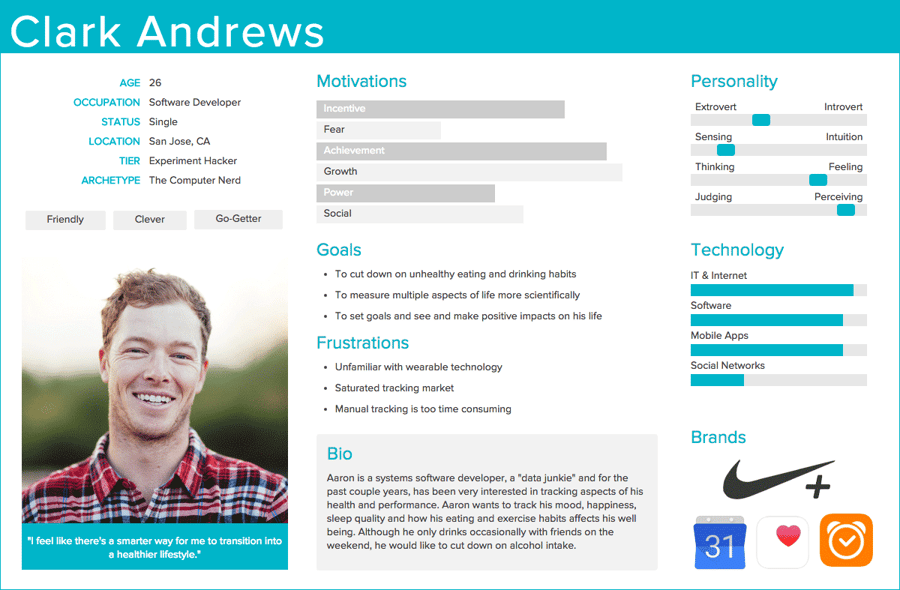
Step 2: Consider the Buyers’ Journey
Once you have a target persona, you must consider the buyer’s journey, which has three stages.
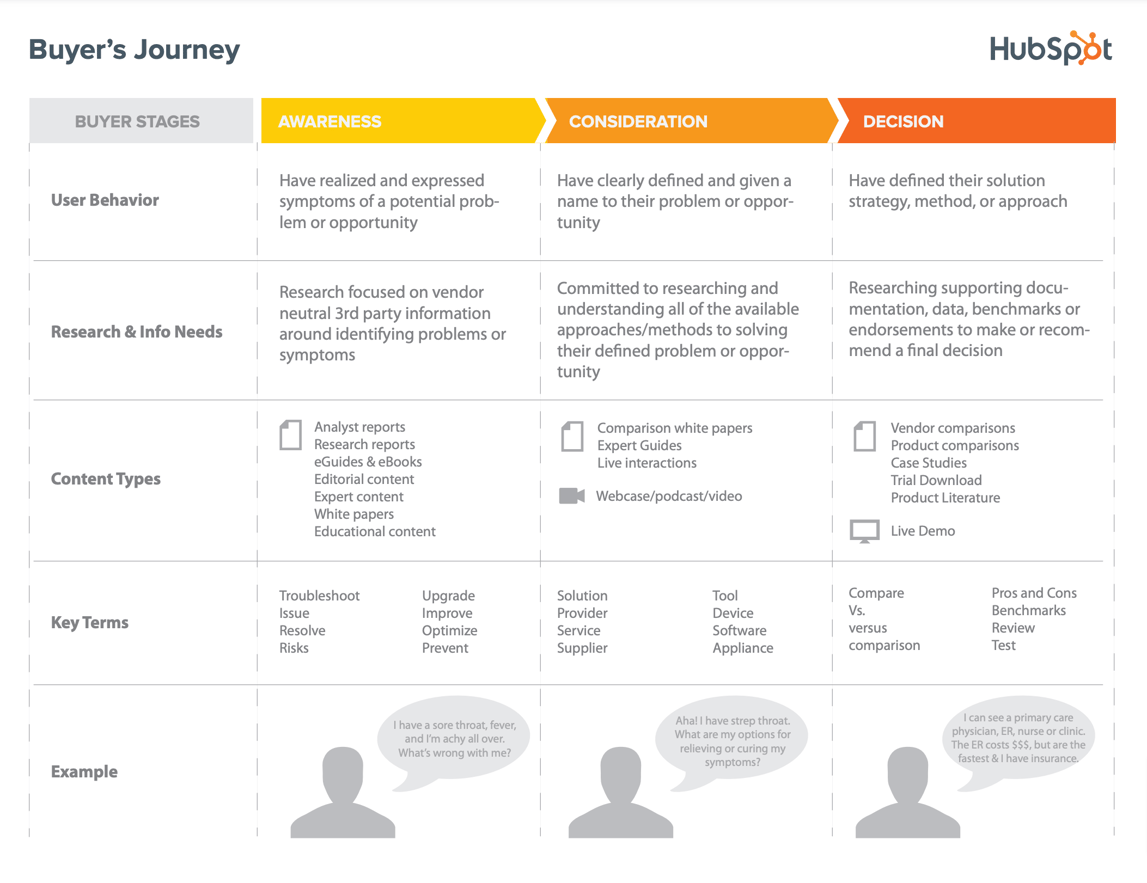
Stage 1: Awareness
At the beginning of their journey, your buyer is unaware that your drug rehab center exists, and that they need it. During this stage, you need to create an awareness of your service, so that the buyer can help understand what you do and what you can do for them.
Once they realize they need you—for example, to address a family member's drug problem—they will start researching. Often, people turn to Google, where they will look for educational material, success stories, and answers to basic questions.
Your website needs to have all this information readily available, but also consider adding a sign-up box, which you can use to capture email addresses. Since they’ve addressed an interest in your service, you can use this opportunity to email them with more success stories and treatment options a few days after they look at your website.
This allows you to keep building trust.
Stage 2: Consideration
After narrowing their search down to a few facilities, the buyer will dive deeper into research. During this stage, they may reach out to you with specific questions to help them narrow their list further, so make sure there’s an easy way for them to reach you and that the person talking to them has the right information to provide them with. They may even visit you during this stage.
Stage 3: Decision
During this stage, the buyer will finalize the facility they choose, so ensure you are prepared with an onboarding package, customer testimonials, and everything they will need to sign up with your facility.
Remember to stay in touch with them even after they’ve started using your facilities. They will still be looking for more information and research into their pain points. Successful patients will become a marketing tool for you, as they will recommend you to their friends and family, so it will pay off to stay in contact with them.
Step 3: Focus on Your Audience
Content marketing isn’t about you; it’s about your audience. How many websites have you seen where the company’s idea of “content marketing” is posting a weekly or monthly update on activities or company promotions without considering what the audience might be interested in? Too many.
That won’t be you, though. Before you start creating content, understand what your audience is looking for.
This goes back to developing a persona. You truly need to know your audience.
What do they like...
Where do they hang out...
How they like to consume content...
So, what topics would be appropriate? This list is NOT all-inclusive and is primarily intended to get your creative juices flowing.
Services you offer
What services do you offer? Besides the obvious, treatment.
- What does each treatment entail?
- Do you specialize in a specific treatment?
- Do you cater to a specific industry or demographic?
- Is there anything family members would want to understand, for example, how to better manage a recovering addict, or things to watch out for?
Knowing these things will allow you to connect with your potential patient, thereby increasing the likelihood of them becoming admitted.
Drug information
Many family members hear about a drug and Google it to learn more about what it does and who it’s suitable for. Answer these questions on your blog, and you’ll soon see an uptick in traffic.
First-hand experiences
Most recovering addicts will not want to talk openly about their experiences, but you can always offer to publish their story under a pen name. Using real-life examples of your successful patient stories will help engage your audience.
Latest news in the industry
Is there a new treatment? Are there any local or national laws or bills under consideration that might impact your industry? Keep your audience engaged by giving them relevant news information for your niche.
Conduct thorough keyword research using information highlighted in my post about SEO for drug rehab centers, and you will discover long-tail keywords for your industry that offer insight into what your potential patients are looking for. They want informative content, not just sales-driven, so keep this in mind when developing a content tone and standard.
Answer questions
What questions are people asking when they contact you or search online? Most likely, it is something along the lines of these big five:
- Cost or price
- Problems or things to be aware of
- Comparisons (this usually comes in the consideration phase-they’ve decided on 2-3 facilities and they are trying to decide)
- Reviews (perhaps, reviews of xxxxx)
- Best of or awards articles
If you answer their questions and provide value, you not only make it easier for them to find you, but you also gain their trust and are seen as an authority. (Whether they consciously realize this or not.)
Step 4: Decide on Content Formats
People consume information differently, so you need to use different content formats to better target the right audience.
What are the different types of content you can produce?
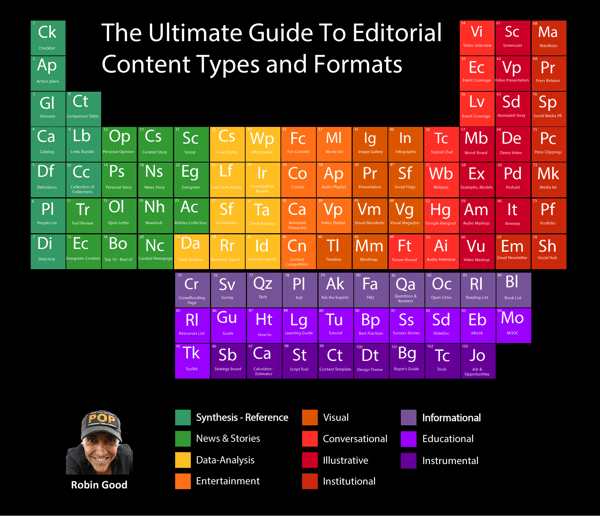
Text-based blog posts and ebooks
Most of your content will be text-based, like blog posts or ebooks. By providing a free ebook download, you can offer something for free to people in exchange for signing up for your mailing list. This will help strengthen your authority in the field and is a great way of sharing a large amount of knowledge in an organized format.
Blog posts are shorter and hosted on your (or another) blog, usually between 500-2000 words. These can be case studies, testimonials, transcripts of interviews, research-based posts that use data to back up claims, or even list-style posts. The bulk of your content will be in the form of text-based posts.
Photos
Share photos of your facility, any events you host, and even industry-related happenings. Using featured images on your blog post and then including these images in your social media shares is a great way to increase click-through rates.
Look for ways you can use your photos to differentiate your center. Perhaps you have a scenic view. Snap a pic, share it on Instagram or any other social platform you are on, and share a motivational quote. You can easily use an app on your phone like Word Swag or Share as Image on your computer.
You'll see an example of one I've created that I use as a motivational quote for my podcast. I then also add this to a "Motivation" board on Pinterest.

Even though I'm not in a visual industry, I can still use images in my content marketing.
Videos
A good video will deliver your message clearly and concisely. Whether it’s a tour of the facilities, an interview video, a clip of an event, or anything else, you can give value to your patients and potential patients with it.
First, decide on the message the video will convey and write the script so it clearly delivers that message. Then, share this video on your blog, YouTube, and Vimeo to drive more traffic.
Don't be afraid to make videos on the fly. Sometimes, those are the best and most personable ones that you can use.
Recommended Reading:
Podcasts
Video and audio podcasts are a great way to connect with people too busy to read content. One great way of re-purposing content is to convert your podcasts into blog posts and vice versa. This way, you’re targeting both the readers and the listeners.
Recommended Reading:
Infographics
Infographics can be expensive, so they’re best used to illustrate data-based information. Since they’re visually appealing, they’re more likely to be shared on social media, especially on visual sites like Pinterest. For best results, consider highlighting new data in the drug rehab industry or some insightful research you’ve come across.
Slides
Slides are a great way of sharing presentations you may have delivered at an industry conference, especially if the content is easily digestible for someone without medical knowledge. You can post them on your website directly, but one way to cast a wider net is to post them on SlideShare and use a call-to-action to direct traffic to your blog.
Ideally, you should use most, if not all, of these formats across your content marketing strategy. Some, like text posts, will be easier to produce and constitute the bulk of your content. Others, like Infographics, may be expensive, which is why it’s better to create them based on research or industry findings once or twice a year.
Step 5: Develop your content calendar
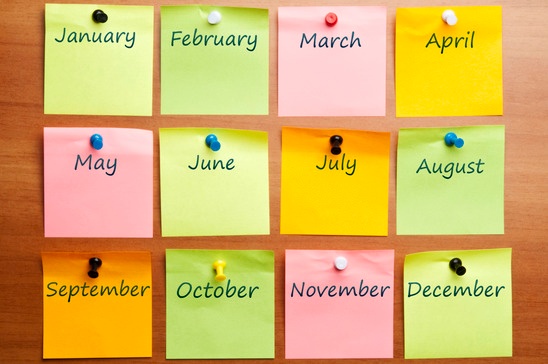
By now, you know what kind of content you will be creating and what it’s going to look like. The next step is setting up a schedule for content creation, the best way to do this is to have a content calendar and follow it.
Assign responsibilities
Will you outsource your content creation or hire someone to work on it in-house? Or will someone already on the team take care of it?
Assigning responsibilities at this stage will ensure your content marketing schedule stays on track. You can outsource content writing to a freelance writer or agency and then have someone within the team post it online and promote it.
However, it is important to consider SEO as a key component of your online marketing efforts. Optimizing blog post titles and meta descriptions and linking to relevant posts on your website and outside can help boost your traffic numbers considerably. If your in-house team doesn’t have the necessary expertise, consider hiring an expert to advise you on this.
Decide on frequency
There is no “one perfect schedule” that you need to follow, so throughout your campaign, you can adjust the schedule as needed. However, a good rule of thumb is to post new content every week and to spend a lot of time promoting it across different channels to get the most reach.
A long blog post every week is a good starting point, although you can share shorter posts or curated content during the week. If you were using testimonials and personal experience stories as part of your content marketing, that would be best done on a set schedule – say once a month.
Consider national or local events
Will you be producing new content for national and local events relevant to your niche? National Alcohol and Drug Addiction Month, for instance, would be a great way to produce meaningful content—not just for your blog but also for guest posts on other relevant sites—at a time when attention is being paid to your industry.
This isn’t the only time of the year to consider, though. Create relevant content for the holidays and major holidays as well—for example, tips to help recovering addicts stay on the wagon around St. Patrick's Day.
Tools to Use
There are many ways to keep track of your content schedule. Read this blog post from Zapier about creating a content calendar.
Step 6: Promote Your Content

Content marketing only works when the right audience sees your content, so promote, promote, promote!
Your email list
Promote all new content to your email subscribers, whether published on your blog or another website. By sharing new content with them before publishing it on your blog, you can provide more value to your email subscribers.
Social Media
Once a post goes live on your blog (or another website) use Buffer or Hootsuite to share it across all your social media platforms. Sharing once is usually not enough, but over-sharing is just as bad, so share it once on each platform in the first 24 hours and then sparingly over the next month. You can also set up website plugins that share old posts on your blog once or twice a week across social media, which may drum up traffic from people who didn’t see those shares the first time around.
Recommended Reading:
Third-party sites like Medium
Some websites, such as Medium, allow you to republish content already published on your blog so that it is available to a larger audience. While Medium allows you to post the entire post again, other websites may share your link with their audience. Regardless, it’s a great way to promote your post across multiple platforms, amplifying its reach.
Step 7: Measure ROI
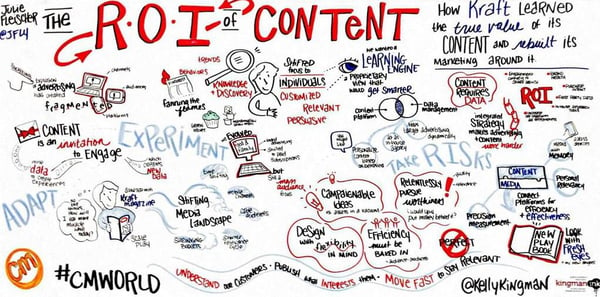
You’re creating a lot of content and hopefully publishing and sharing it on many sources. How are you tracking the amount of traffic each type of content generates for your website?
Usually, your Call-to-Action (CTA), a strongly worded statement that directs people to your website, is placed at the end of every post you write. You can decide where the link directs traffic; for instance, you may want traffic to go to your Services or Contact Us pages. Each CTA will have a unique URL so you can track which CTAs get clicked on the most and where your traffic sources are.
With Google Analytics, you can do this for free using their URL builder. This allows you to create a special URL with tracking information in it. Then, you can use the dashboard to see whether Twitter shares are generating more traffic than Facebook and which CTAs have a higher click-through rate.
However, if you are using marketing automation software such as Hubspot, the software will keep track of everything for you, so you don't have to check a bunch of different software to get the needed reporting and analytics.
Step 8: Use Retargeting
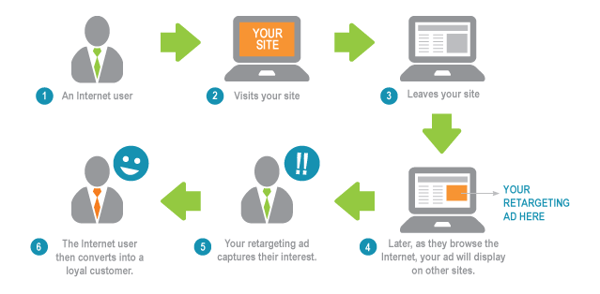
Convert your audience into phone calls with retargeting. Simply put, retargeting uses display advertising based on the actions a visitor on your site takes. Once they leave your website or a specific page on your website, you can use retargeting to remind them of your services by using ads.
When someone spends time reading content on your website, let’s say about a specific treatment, and leaves without getting in touch, you’ve potentially lost a lead. However, with retargeting, you can keep sending reminders about that interaction they had with your website and possibly entice them to come back and get in touch with you.
Honestly, the problem with retargeting is that some people find it creepy and may not want a reminder of their recent visit to your website displayed on every other website they visit. You can set your campaign so it avoids the creepy factor, but my advice with retargeting is to use it sparingly and after considerable research, as well as HIPAA compliance.
Conclusion
An unbeatable content marketing strategy is a must-have for any business, but especially a drug rehab center. Your patients expect you to be the authority in your field and trust you with their lives. By creating well-thought-out content, you will be able to build a brand that your patients will trust and be loyal to. Use this guide to create the best content marketing strategy possible, so that you can boost your lead generation and impact more lives than ever before.
About the Author
Tyson Downs is the founder of Titan Web Agency, a company specializing in marketing for dental professionals. With an impressive track record of working with over 100 dental practices, Tyson has a deep understanding of the unique marketing needs within the dental industry. His expertise has helped numerous dental practices flourish by meeting and surpassing their revenue goals and established him as a thought leader in healthcare marketing. His insights and strategies have been featured in esteemed dental publications, including the American Dental Association and the American Academy of Implant Dentistry. Before dedicating his career to helping dental professionals thrive through effective marketing, Tyson honed his skills in SEO and web design as a freelancer, while also gaining valuable experience in the corporate sector. As an alumnus of Brigham Young University, he brings a strong educational background to his entrepreneurial endeavors. Outside of his professional life, Tyson is a devoted father of five, who cherishes time spent with his family, especially when they're all enjoying America's pastime on the baseball field.
Leave a Reply 0 comments



